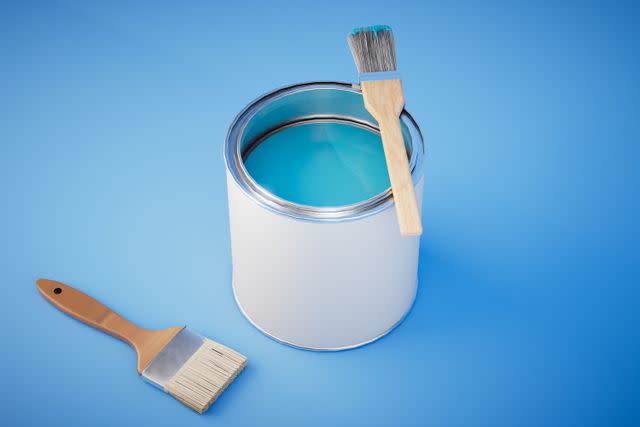How Much Does a Gallon of Paint Cover?
Short answer: It depends.
Painting a room is a fast and inexpensive DIY project that'll give you a big refresh. But figuring out how much paint you need can be a little bit of a challenge. So how much does a gallon of paint cover? Here's everything you need to know to calculate the amount of paint you need for your next project—so you don't wind up short or end up with an unused paint gathering dust in storage.
Related: How to Paint a Wall Like a Pro

Ihor Lukianenko/Getty Images
Find out what the paint manufacturer recommends
Different paint manufacturers—and even different paint products—have different coverage recommendations, so your first to-do is to see what the paint itself says. "In general, a high-quality gallon of paint should cover about 400 square feet," says Nicole Gibbons, founder and CEO of paint company Clare. "Paint brands tend to have good, better, and best paint formulas with slightly different price points and quality levels. The more premium your paint is, the better it will cover, so a good paint will cover less than the better paint, which will cover less than the best paint."
You'll find that the primer covers less than the paint itself, so you'll likely need to buy more of it—as a typical primer usually covers about 200 square feet, Gibbons says.
Check out the surface texture you're painting
In general, textured or porous surface requires more paint than a smooth and nonporous surface, like trim that's already been painted. But there's a way to minimize the issue. "When you’re painting really porous surfaces, such as brick, or drywall, or if your walls are textured, or if you have recently done repairs resulting in patches, primer is very important," Gibbons says. "Primer helps create a uniform base on your walls so that you have a uniform color, a uniform application, and uniform coverage, in addition to ensuring your paint lasts longer."
Related: 8 Professional Painters Share Their Top Painting Tips
Factor in any color changes you're making
You may need more paint if you're making a drastic color change that could require multiple coats of paint. "Generally, only one coat is needed if the new paint color is in a similar color family to the existing color," says Ed Edrosa, senior project manager at Behr. "That said, a drastic color change—such as a neutral color being painted over a darker color—may require a second coat for full coverage."
Do a little math to figure out the paint coverage in your room
You may think you can just use the square footage of your room, but that's not exactly the case. "The most important thing is calculating the square footage of your wall space," Gibbons says. "Many people confuse the square footage of their home, which measures floor space, for wall space, when you actually have about four times the amount of wall space than floor space."
Many paint companies, including Behr, offer calculators that you can use to determine how much paint you need. But Edrosa also gives easy formulas you can use to determine how much you need.
For ceiling projects: Multiply the length by the width to get the ceiling area and divide by 400 to determine how many gallons of ceiling paint you need for one coat of paint.
For wall projects: Add the length of each wall, then multiply by the wall height to get the total wall area. Then, subtract 20 square feet for each door and 15 square feet for each window in the room (get exact measurements if you have custom doors or windows) and divide by 400 to determine how many gallons of wall paint you need for one coat of paint.
For trim paint: Add the length of each wall then multiply the sum by 0.5 for an estimated width of the trim and divide by 400 to determine how many gallons of trim paint you need for one coat of paint.
Related: 7 Mistakes Everyone Makes When Painting
Add some wiggle room
You don't want to be too precise when you're calculating for paint—and err on the side of too much. " it’s good to plan for overages, Gibbons says. "For a typical room, not excluding doors or windows means you'll have enough for touch-ups and if you have any unforeseen issues or spills." She recommends simply ignoring cutouts like doors and windows to give you that wiggle room.
Edrosa recommends adding 10 percent to your calculations to ensure you have enough paint for additional coverage. "It’s always safe to buy more paint than you think you may need, especially when using a custom color to ensure the colors do not vary in the room," he says.
For more Real Simple news, make sure to sign up for our newsletter!
Read the original article on Real Simple.

